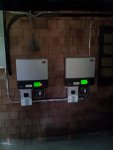The older SMA Sunny Boy 8000 always had the benefit of being installed with a 40 amp breaker on 240 volt single phase system with no issues. The maximum output of 32 amps multiplied by the code mandated fudge factor of 1.25% equaled exactly 40 amps.
Well, the newer 8000TL has a maximum output of 33.4 amps at 240 volts, and a 40 amp breaker no longer is compatible when the 1.25% is added.
I don't know why SMA would do this. That was the main advantage of the 8000. it could be installed on a 40 amp breaker in a 200 amp panel without isssues and be code compliant.
Well, the newer 8000TL has a maximum output of 33.4 amps at 240 volts, and a 40 amp breaker no longer is compatible when the 1.25% is added.
I don't know why SMA would do this. That was the main advantage of the 8000. it could be installed on a 40 amp breaker in a 200 amp panel without isssues and be code compliant.
Last edited:


